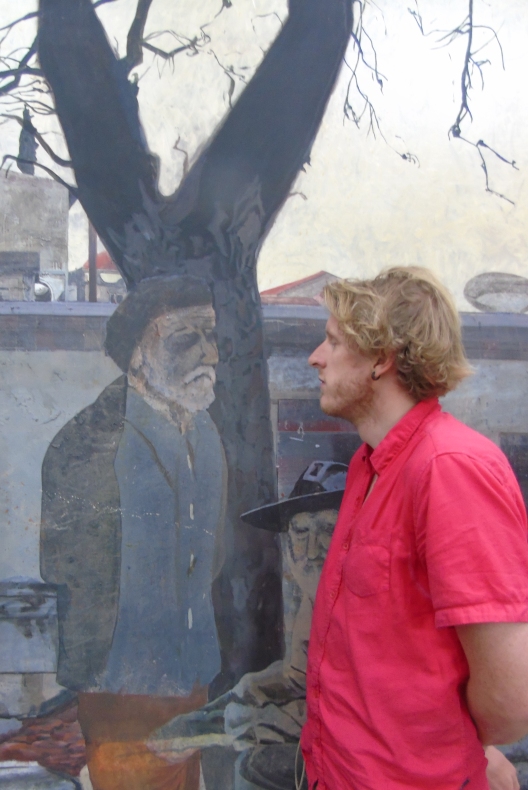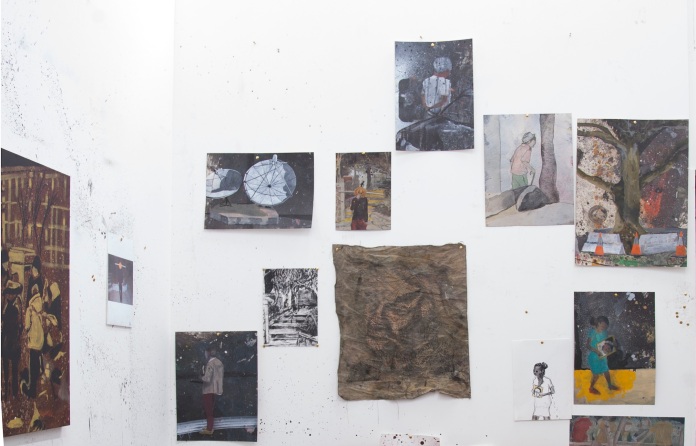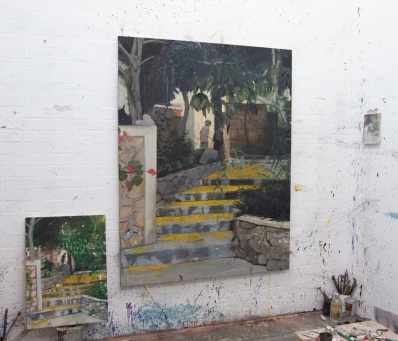
Marcus next to an early version of Handshake with a Giant (2018)
Marcus Cope is an English painter working out of APT Studios in London. He’s also a curator and the co-founder of the Marmite Prize, an award for painting. His thought process, not only on his own painting but on art in general, is fascinating and insightful – my conversations with him have really made me think differently about how I look at art and its relationship to the viewer. I hope this interview is as thought-provoking for you as it was for me.
Let’s talk about the painting that you’re working on at the moment.
This painting is a story of a moment in Turkey over a decade ago. I went with my girlfriend, travelling from Northern Cyprus to southern Turkey by ferry – there was a delay once we were on board which made for a really long journey, almost 24 hours I think – and this ferry was very basic, no café, or shops, not quite like the ferry you would take from Wales to Ireland.
Once we arrived transport was difficult, we got on a bus but that didn’t quite work out so we got a dolmuş, one of those shared taxis. When we got off in this little town called Silifke, there was this old guy sitting there, under a tree… and he just came up to me and shook my hand, and he was so happy to see us, and welcoming. At that moment for us, everything was new because we were the ‘out of towners’, but he saw us, and we must have stood out, both looking like we were new to this town in southern Turkey, both with wild blonde hair. For him it must have been like, ‘Wow, look at these guys!’. Something different to the norm, coming into his town. For us, it was like this whole weird thing, and we were so knackered from travelling, so I guess that made it a memorable moment in that sense. And he is represented in the painting by one of the figures.

Handshake with a Giant (2018), oil on canvas, 300x210cm
Part of the work of making the painting is trying to remember that situation, I mean, to ask ‘Where was he?’, ‘What was the situation around that moment?’. So the process then is me finding an image of the tree and whatever else surrounded it, substitutes of the situation, the scene, finding this stuff, finding the right images to try to recreate the moment in an image. The [image I used for the] guy comes from a postcard that John Kasmin had collected. John established the Kasmin Gallery in the 1960’s, but he’s also an avid postcard collector. He’s produced a few of these books of his postcard collections and I found a picture of this guy in one of those books, and he seemed to fit the bill. The other figure in the painting is a partial redition of a guy I had taken a photo of in the Serpentine Gallery, looking at a painting by Hilma af Klint.
So, there’s a little bit of me trying to remember the scene, but I’m also putting things together so it feels organic – those decisions are in the editing. Most of my paintings are total compositions of other stuff… I either make up a space, or I find an image that seems like the right thing, or an image of the actual thing, and then everything else comes together during the painting process.
I’m always a bit cautious of leaning into representing memory – this moment is a fleeting memory, he’s kind of there but he’s not there. From my point of view everything should be a little transparent in the picture, not just the figures. I think this painting… maybe it has a slightly filmic quality, imagining these ghostly figures in the way you remember a place where something significant has happened. There is something about how a person is central to a painting, and yet I tried not to overemphasise that, or ‘over-paint’ their features – it could be a slippery slope, I think. I just tried to keep that sort of feeling of their simply being part of the painting, part of the place. It’s quite a tricky thing to do, every time I paint a face I wonder, ‘How do I do this?’, it’s like I haven’t ever done it before…
I intend to call it Handshake with a Giant. In this situation I’m the giant, but you can’t see me because it’s from my viewpoint (which is quite a high vantage point). I want it [the title] to be intriguing, or something to make you think, because there isn’t actually a handshake going on and there isn’t a giant. Titling paintings is a tricky one, because obviously with every painting I make, I don’t know if I am even going to get an opportunity to show it. I don’t really think of the title, maybe sometimes it just brews up and appears as a thought, or I think about the title, but not in relation to the audience. When you show a painting, the title becomes your opportunity to have a little influence on the conversation with the viewer, which is something I’m always debating, how instructive or descriptive it should or could be.
There is something very unique, very personal, about your work.
Yeah, all the paintings are stories of people I’ve met, or places I’ve been. I just had an exhibition (in May 2018) at studio1.1, an artist-run space in Shoreditch,– I had five large paintings in the exhibition, and four of these were scenes from Cyprus and the other was of my kitchen in London with a little story from Ireland thrown in. I’m kind of painting my history.

Stealing from the Natives, (2017), oil on canvas, 300x210cm
I could have marketed the show as Paintings of Cyprus, because all the stories came from time spent in Cyprus or people from Cyprus – it’s a place I’ve been to several times, a place I went to when I finished my degree [in 2003 to do a residency at the Cyprus College of Art]. I don’t feel like it works in that way, where there’s a strategy or a tagline. They are just the pictures that I want to make, so they are personal. It just happens to be that a lot of it is in Cyprus. I do sometimes think I should make some London paintings, but I don’t want to force that.
At one point I felt that every (solo) exhibition I had had to be a complete 180 turn from the last. It was madness, that I felt that way. I remember quoting Lichtenstein in an essay for college, where he said that when he was 31 or 35 or something he discovered his way of making paintings – that we all know as the dots – but before that everything that he was doing, even though he didn’t know it at the time, was him experimenting, trying to find his way, his visual language.
Looking back at my desire to make things different all the time was part of me not having my voice yet… I wouldn’t say I was looking for it, or didn’t realise I was, it sort of fell on me, you know? It found me! I did paintings that were tight, photoreal paintings, and now they’re quite loose, never really abstract but sort of verging on it. Two ends of the spectrum I suppose, and that probably comes from learning about paint and what it does, how to use the mark making, and the simple stuff, maybe? It doesn’t feel like I’ve got that urge to change that I used to have, and even now that I’ve just had a show… I’d like the next show to look a bit like that that one, because it was really good! Yeah, I couldn’t imagine doing it any other way.
Let’s talk about your day-to-day practice.
My general routine is either I do a day of work and childcare, and I come here at nine pm when I’m a bit tired, or I come here at nine in the morning. I think it probably affects my approach, because at night I’m much more relaxed, a little worn out from the day. If I’m here during the day, it usually means that I’ve got to go pick up my daughter from nursery later.

Marcus’s studio wall in APT Studios
So, in the morning I try and do watercolours or oil sketches and then come downstairs and do an afternoon of painting. Painting can just take over – so it’s really important to keep creating drawings for future works, even when I’m painting and I’m in the thick of it, because you can come to an end of a painting and feel like ‘What the fuck am I going to do now?’. I need to continue generating the ‘stuff’ that goes into the paintings. I also have things to work from, or to work out within the painting that I might try and resolve with a sketch. I work on several large paintings at the same time, and also I do other things that come up, little sketches, note taking, thinking! It’s a little bit more of a natural process, even with the best intention of ‘finishing’ something, I will find myself working on something else. I sometimes need to take myself away from painting for a bit, to contemplate what’s happened, then do some drawing… I need to be bouncing between them. But when a painting is at the point where it’s close to completion, when it takes off and I have that feeling that’s it’s all open for manouvre, it does take over; it does become my whole focus. There might as well be nothing else.

Eight Years Ago, (2018) in studio
I have this way of working with a lot of the paintings – I’ll paint something on and I’ll flick paint on it, or some turps and then I’ll get a rag or some off-cuts of canvas and I’ll soak it with some other paint and push it on [the surface]. There is a lot of physicality in the process and yet it’s kind of a vague thing to describe. When you look at anything in the world, nothing is flat clean white – green – red- etc, there are always details, there is stuff in everything, even just due to light, and I try and give every surface of my paintings that feature. I often think, for me things begin to get tighter and neater as the work progresses and gets close to completion, and when I find that I’m going in that direction I’ll pull back in some way, and that is the moment when it can all come together.

Eight Years Ago, (2018), oil on canvas, 170x130cm
Your work often references some of your older pieces – what is the thought process to that?
I guess the most immediate example of this would be Out the Back (2017). In it, there is a vulture’s eye, and yeah, I think it was kind of symbolic of the end of something, and the beginning of something else. The vulture’s eye comes from a series of vulture paintings I did in 2011 called Carrion, where I had based my work on research I’d done into vultures. On reflection it led me down the wrong path, in a way. Anyway the eye seemed to fit in with this outdoor studio which is taken from a photograph I took over a decade ago of the old backyard of the Cyprus College of Art in Limassol. I suppose putting bits of the vultures in there – it’s sort of like putting bits of me, my history of painting, into the work. It’s something that led me towards where I am today. In the end, regardless of content for me, every painting is a series of decisions I have to make, and I try to be very careful with that.

Out the Back, (2017), oil on canvas, 170x250cm

Aegypius Calvus, (2011), oil on canvas, 120x85cm
I would add though that those references made to older works are fading fast. And when they do appear I’m not usually completely conscious that I’m doing that. There aren’t any in any of the current work.
As we all do I look at other people’s work on Instagram, and for example… the other day, someone posted a painting of an old Spanish lady with a turquoise face, and I thought, ‘Why does she have a turquoise face?’. It sort of seems like people can be flippant with the colour they use. For whatever reason I can’t do that at the moment, that’s not for me, but it once was and could be again, but for now I want the colours to be representing reality, or at least my perspective on reality. I guess that’s what they were doing for the turquise lady painter too. In the past a turquoise face wouldn’t have been something I’d have questioned.
I see you worked with Sacha Craddock on some accompanying text with your last exhibition – would you care to touch on that?
It’s always interesting when someone else engages with what you do. Sacha came in here, and said: “I don’t want you to tell me what you think they are about – I’ll tell you.”
She is interesting. To have that perspective, that comes from forty odd years of experience dealing with art… she has much more experience than me. So often people don’t really tell me what they really think. Or maybe they say what they think I want to hear!
I had asked her to write a text for the exhibition, I respect her opinion. She was adamant the paintings are not about the stories, it’s still about the painting and what it looks like. The story is the starting point for each work, and directs the collection of the visual materials, but from there it becomes about my relationship with making paintings. This is totally true. That relationship is formed through decisions (editing), and that’s how the piece of work became this thing in front of you. For so many years when I went to the studio, I wouldn’t know what to do, so I would just do anything! I’ve always been very productive, and I do sometimes think, when something went against the last thing I did, I thought that was enough. That sort of confusion in what was going on, it meant there must be something going on, but now I just get on with it, because there is something going on. No questions. There’s another story and another encounter and another situation that is occupying me, and that directs the image search, becomes the sketches, develops the paintings… so it feels really positive.
Finally, can we talk about some of your influences?
For a long time I was really into Pieter de Hooch and Gabriël Metsu, those old Dutch guys. And whenever I go to the National Gallery or the Wallace Collection, those are still the ones that I’m drawn to. But these days I’m more influenced by people like Daumier, or Jean-François Millet, their paintings and drawings of real people in real situations. Especially the sort of paintings Millet did, a lot of paintings of people working in fields – they were a big influence.
I’m a lifelong fan of Philip Guston, that never seems to abate. And Goya of course.
One of the big recent influences was seeing the Daniel Richter show at the Camden Arts Centre a year and a half ago. That show, I thought it was really hit and miss, but the ones that hit, they really hit. And that’s what made me realise my desire to do my paintings really big – because when you’re confronted with a painting that kind of size, and the figures in it are almost life-sized, you have that real sense of it being an actual space that you can interact with. I suppose that’s kind of theatrical. I like that. I remember I came away from that show and ordered some big stretchers straight away. It was a very immediate response, almost overwhelming that desire to do that.
More recently I’ve been thinking about the subtleties of Vuillard and Bonnard – and perhaps even Sickert – and how they got their figures into spaces without them dominating. It’s great stuff!
You can find out more about Marcus’s work through his website link below
thank you Adrian Mc Hugh for your work editing
You can support Painting in Text through Patreon, link below
https://www.patreon.com/PaintinginText
